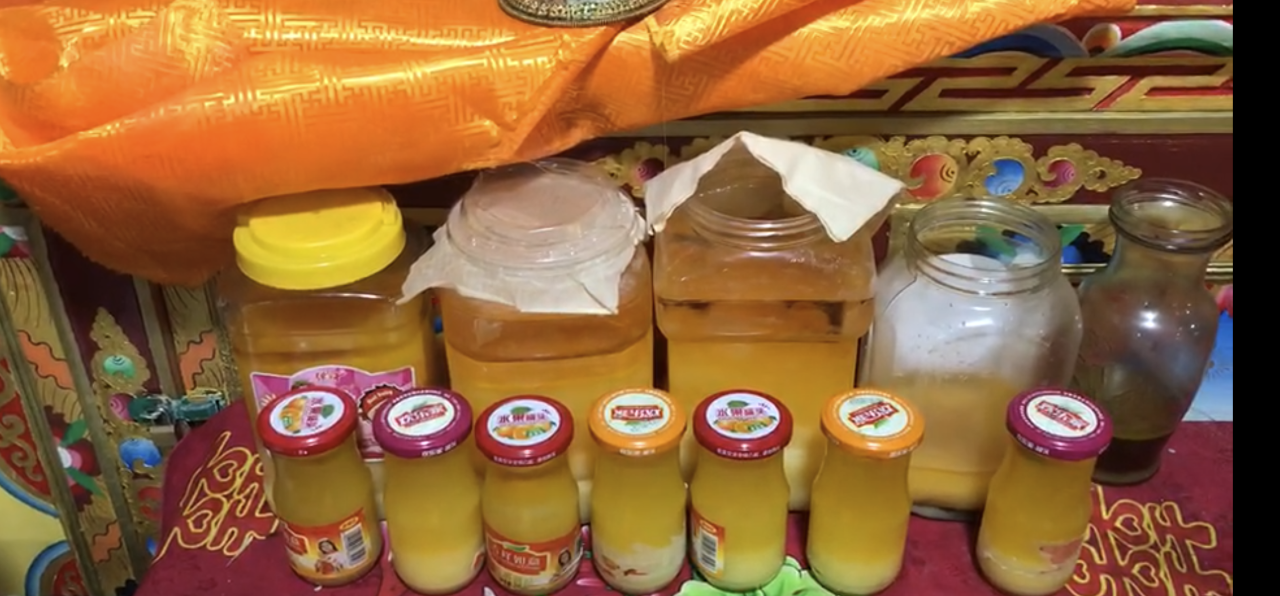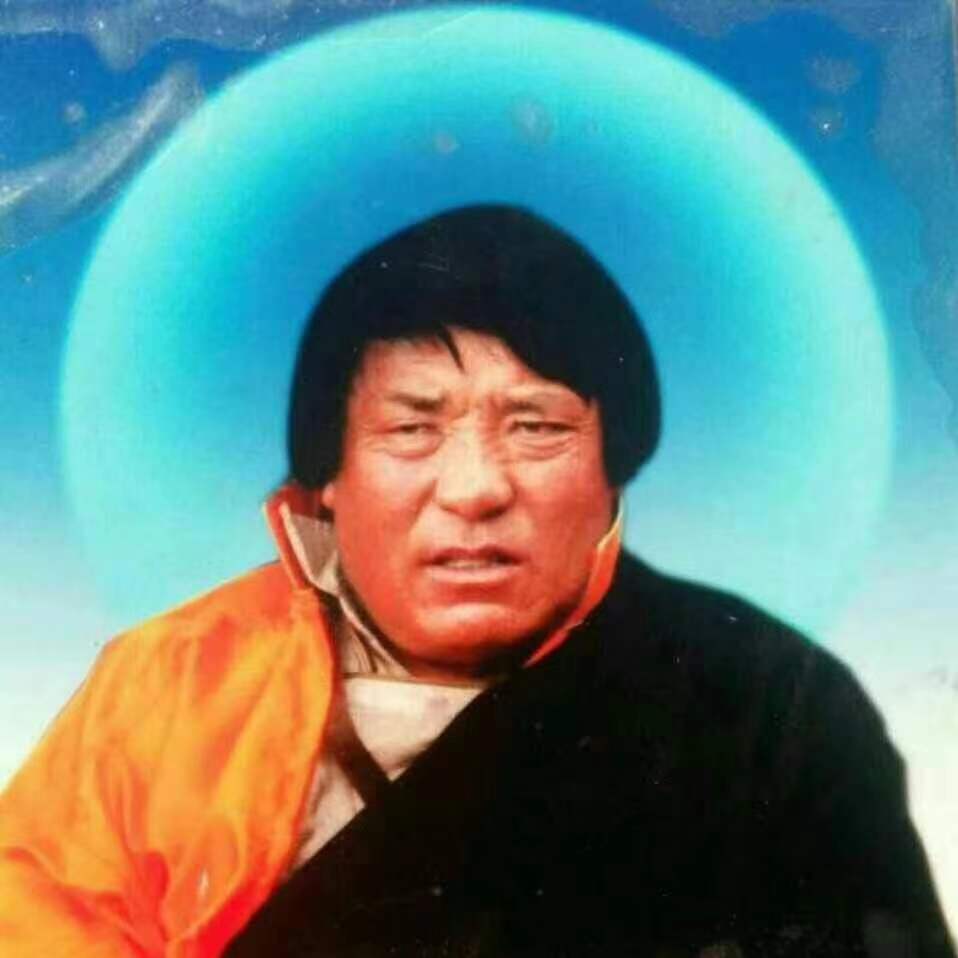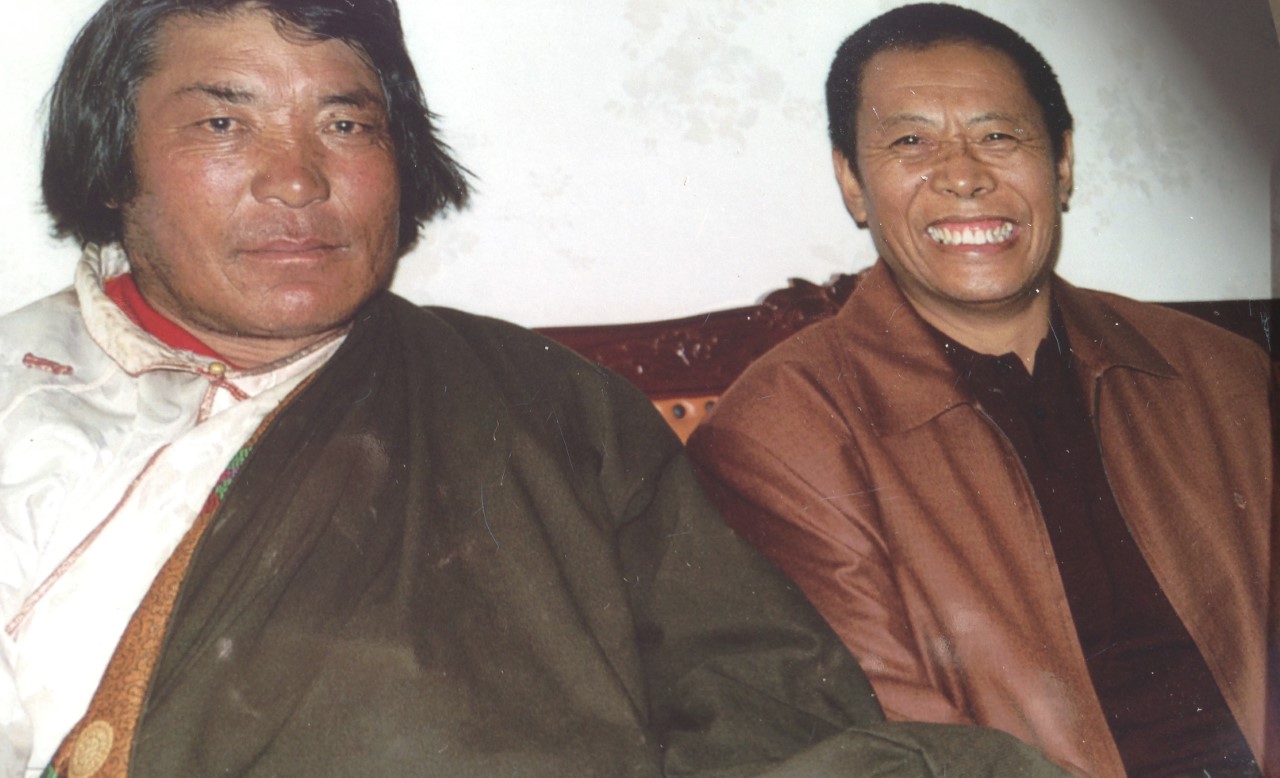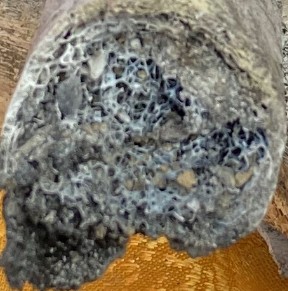The Miracles of the Parinirvana of Namchak Tulku Pakpa Gyatso Rinpoche
(1950 – 2020)
By Khenpo Namchak Dorji
Previous Incarnations
The roots of this story can be found in an account of the most famous Tibetan mantrika known as Sangye Yeshe of the great Nub clan. He is depicted today in paintings and sculptures as a majestic man with a long goatee like the kesh of a Sikh man, a hat with a broad flat brim and three flaming bloodshot eyes, and a wide-sleeved brocade gown, all of which constitutes wrathful attire. He carries a rudraksha mala and is stabbing a ritual dagger into a rockface. It is no wonder that this has become a standard image of a mantrika for Vajrayana Buddhists in the Himalayas, where several Tibetan masters who became famous for their mantra powers have been depicted in this way, including Tsasum Lingpa in Tibet and Zhabdrung in Bhutan. This attire became the lama costume widely used in wrathful rituals and black hat dances. All specific references to this attire and its symbolism allude to the carrying out of wrathful mantra activity, which involves the forceful liberation of those evil beings who cannot be tamed by the buddhas and bodhisattvas through the enlightened activities of pacifying, enriching, and magnetizing.
In the 8th century C.E., the Tibetan emperor Trisong Detsen invested the most of the gold reserves in his treasury to bring Buddhism from India to Tibet. At that time, a nine-year-old boy named Dorje Tritsuk was selected to study at the royal palace. When the Nepalese dharma king Basudhara taught at Samye, he was astounded and captivated by the intelligence, diligence, and devotion of this young boy, who not only received and practiced sacred Vajrayana empowerments and teachings, but also requested further sacred pith instructions with offerings of gold. Basudhara promised to teach Dorje Tritsuk if he followed him to Nepal. Dorje Tritsuk sold the orchard he had inherited for gold and travelled to Nepal, where he received numerous teachings. Since his decision to receive and master all the wrathful mantra teachings to protect Buddhism in Tibet was strongly backed by Emperor Trisong, in order to fulfill his mission he travelled from Nepal to Bodhgaya, where he met with such great masters as Rombuguhya. While Dorje Tritsuk was practicing at Bodhgaya, he had a vision of Vajrapani who bestowed upon him the name Sangye Yeshe.

It is said that Sangye Yeshe travelled to India, Nepal, and Gilgit seven times during his life and received all the sacred mantra teachings, including all the wrathful mantra teachings available at that time, by relying upon more than thirty great mahasiddhas. Nubchen Sangye Yeshe is among the nine heart sons and the twenty-five foremost disciples of Guru Rinpoche, and is renowned as the king of mantrikas in the Land of Snows. Although all the disciples of Guru Rinpoche attained realization and displayed various signs of accomplishment at that time, Nubchen’s case was a very special one. He not only mastered the practice of Yamantaka (the deity of enlightened form among the Eight Great Heruka sadhanas bestowed by Guru Rinpoche), he also displayed miraculous powers, such as flying like a bird, stabbing a ritual dagger into rock as if into soft clay. He was also a great translator, translating and disseminating several tantra teachings that he received and also composing several treatises to protect and safeguard the Buddha’s teaching in Tibet. He hid several cycles of Yamantaka teachings as termas—hidden treasure teachings—for the benefit of beings in the future.
According to one account, Nubchen went to India when Guru Rinpoche was in Tibet, and upon his return he offered the transmission of a sadhana teaching called Tobdü Nakpo to Guru Rinpoche as a gift. Nubchen’s autobiography recounts that, after Guru Rinpoche left Tibet Nubchen reunited with him at the India-Nepal border where he received more Great Perfection teachings
One fascinating account, reiterated in every history of the Nyingma tradition, credits Nubchen Sangye Yeshe for saving Buddhism at a time when Tibetan king Langdarma was committed to eradicating it. One day, when King Langdarma made the audacious claim that he successfully destroyed Buddhism in Tibet, one of his queens said, “How can you claim this if you haven’t yet been able to vanquish the entire group of tantric practitioners in the Nub valley, led by Nubchen Sangye Yeshe?” This prompted the king to immediately summon Nubchen and boast, “If I have destroyed the Dharma to this extent, what power do you have left?” To this Nubchen replied, “Well, I have this slight power of reciting mantra,” whereupon he displayed a threatening mudra in space and nine scorpions appeared, stacked one above the other and each the size of a yak. Once again Nubchen said, “I have other powers I can show you.” He then performed the threatening mudra, pointing at the cliff face on the opposite side of the valley, whereupon it shattered into dust. With that, the king became totally terrified and responded, “Please continue your practice of the Dharma. I will never harm you or practitioners like you.” Shortly after the king made this pledge, he was assassinated by Lhalung Palgyi Dorje. It is said that, due to Nubchen’s power, all three inner yoga teachings of the Nyingma lineage were maintained and continue to flourish. He is known as the great charioteer of kama and terma teachings of the Nyingma school, because all three mainstream transmissions of inner yoga (Maha, Anu, and Ati) came together in him. In some accounts he is said to have lived more than one hundred and thirty years, from the Emperor Trisong’s reign until that of King Palkortsen, the grandson of Langdarma. Nupchen’s body finally dissolved into light.
Many wrathful mantra teachings, especially those related to Yamantaka cycles, were later revealed by his successive incarnations, such as Tsuklak Pelgye, Dumgya Zhangtrom, and Bönpo Draktsa. Among his incarnations, the treasure revealer Tsasum Lingpa, also known as Garwang Namchak Dorje (1694–1738), appeared during the time of a Mongolian invasion of Tibet, when Nyingma monasteries were destroyed and Nyingma masters and practitioners were massacred. Tsasum Lingpa was prophesied to be an incarnation of Nubchen in a treasure teaching by Guru Rinpoche which stated, “Seventeen lifetimes from now, you, my son Nubchen, will appear with the name of Namchak, with an unpredictable personality, and you will wander like the wind.” Many such prophesies can be found in Pema Kathang (The Edict of Padma) and other terma texts. As prophesied, from childhood Tsasum Lingpa was extremely unconventional, unpredictable, and wild. Within a span of ten years, by travelling to more than thirty-nine treasures sites he discovered more than seventy-five sections of terma teachings and an enormous amount of treasure substances hidden by Guru Rinpoche and Nubchen. The sites included the Powo and Pemakod regions in eastern Tibet; Samye and Drigung in central Tibet; and Kongpo, Dakpo, and Mon Tawang in southern Tibet.
Although Tsasum Lingpa was not formally credited by the government or the public, he states in his personal account that the Mongolian forces immediately retreated after he revealed and practiced the four wrathful teaching cycles known for averting invasion (ta-mak dok-jed drak-poi chö-zhi). These four wrathful cycle practices are Shinje Dukri Mebar (Yamantaka: Flaming Mountain of Poison), Yangpur Gau Marnak (The Dark Red Amulet: The Union of Yangdak and Purba), Kilaya Dugyi Parbu (Vajrakila: Repository of Poison), and Zhingkyong Rudar Makdok (Protector of the Realm: The Martial Banner Turning Back Armies). Following this, the seventh Dalai Lama ascended to the golden throne and restored peace and harmony in Tibet.
Toward the end of his life, Tsasum Lingpa became the head lama of the king of the Powo region and soon after that passed into nirvana. Since then, there have appeared lineages of successive incarnations of his enlightened form, speech, and mind, many of whom were also tertöns (revealers of hidden treasure teachings), as well as being great mahasiddhas. His form incarnations were Rong-nyön Orgyen Rigzin, Orgyen Drodul Lingpa, Pema Ngedo Tendzin, and Ngedön Chöying Rangdrol. Only one speech incarnation appeared, who was known as Sungtul Chime Lodrö. The mind incarnations were Rigzin Mijik Dorje, Ngawang Nyendrak Gyatso, Sang-ngag Tenpey Gyaltsen, and Zöpa Rabten, with Pakpa Gyatso and Trinley Gyaltsen simultaneously being the most recent mind incarnations.

Namtul Pakpa Gyatso Rinpoche
A boy was born on the Blessed Rainy Day in the autumn of 1950 to Nanam Gyaltsen of the Poyo clan of rulers and Drolma Yutso of the Sharza clan, in the region of Kham Kyungpo Meru in eastern Tibet. Villagers were busy bringing in the harvest, when suddenly an eccentric man named Gampa Jampa shouted, “Oh, look at the beautiful rainbow over that house!” and said, “Maybe a tulku has been born in that household.” This comment, although perhaps made in jest, was auspicious because nobody knew at the time that a Namchak tulku was actually born until later, when the boy was formally recognized—as the sixth incarnation of the tertön Namchak Tsasum Lingpa—by Jedrung Jampal Gyatso, a highly renowned master of Kham Riwoche. The previous Riwoche, Jedrung, Trinley Jampa Jungney, and the fifth Namchak tulku, Zöpa Rabten, were both companions, as well as chief disciples, of Drubwang Shakya Shri (1853–1919). Later, when he was five years old (in 1955), the Namchak monastic community, represented by Pakpa Lha Gelek Namgyal of Chamdo (who was then the chief lama in that area), the governor, and all the local rulers in the area endorsed him unanimously as the Namtul (“Namchak incarnation”). An elaborate enthronement ceremony was performed, attended by thousands of people including the Bön communities of the region.
Namtul Rinpoche’s rigorous training in the Dharma took place at Namchak Monastery, along with Gochen Tulku Sang-ngag Rinpoche, under their tutor Lama Namchak Tashi, the father of Tulku Sang-ngag Rinpoche. It was then that they both received all the empowerments, instructions, and transmissions of the Namchak treasure cycles from Gadra Lama Nyima Odzer (1915–1988), the chief disciple of Drubchen Jo Rigzin, the previous Namchak Tulku Zöpa Rabten, and Jedrung Jampa Jungney (1856–1922). Tulku Sang-ngag Rinpoche still recalls the funny moments of their childhood when they played together, sometimes getting scolded by their teacher for being naughty. Later, in 2016, Namtul Rinpoche met Tulku Sang-ngag Rinpoche and received the entire series of empowerments for the Namchak teram cycles. After that Namtul Rinpoche in turn bestowed the entire series of Namchak empowerments on several thousand disciples in Tibet. Namtul said that when he was young he also met Pegyal Lingpa (1924–1988), the other contemporary incarnation of Tsasum Lingpa, and they performed a drupchen practice together.
In 1959, during the Cultural Revolution, everything was suddenly turned upside down for Namtul Rinpoche and he had to endure numerous hardships. For decades he was punished for holding the rank of an incarnated lama, although he was not actually imprisoned. In addition, his father had become disabled, unable to move, and he had to shoulder the responsibility of taking care of his family as well as the monastic community. This prevented him from receiving further spiritual training.

Gradually, when the situation improved and the dissemination of the Buddhadharma was permitted in the area, he managed to obtain permission to carry out a project to rebuild the Namchak temple, which had been destroyed during the Cultural Revolution. He desperately struggled to gather the needed funds, and consequently embarked on a difficult journey over several years to collect donations, engage in small businesses, and devise other methods to fund the project, working day and night, summer and winter, throughout the year. Through his courage, consistency, faith, and devotion to the Buddhadharma, within a couple of decades Namtul Rinpoche completed the building of the monastery complex, including statues and stupas, surpassing the splendor of the previous structures. He established both a shedra (a place for the monks to study) and a drupdra (a meditation center), as well as facilities for all the lay practitioners to study Buddhism. He also built a magnificent temple, a multi-storied Zangdok Palri (Copper-Colored Mountain of Glory) with thousands of statues and mural paintings inside; a temple of the one hundred peaceful and wrathful deities; and a giant stupa modeled on the one at Boudhanath in Nepal. He also commissioned the entire canon of the Buddha’s teachings and the commentarial treatises (Kangyur and Tengyur) to be engraved in stone, and founded a new charnel ground.

Namtul Rinpoche used whatever offerings he received to provide spiritual services to his devotees for the benefit of others through projects at his own or nearby monasteries, for community services and humanitarian acts. In brief, he extensively engaged in community services such as preserving natural environments; building homes for the elderly; and establishing funds for drupchen, drupchöd, and mönlam chenmo ceremonies in several monasteries and communities.

Throughout his life, he was renowned as a straightforward and dignified person. As a result, people with negative intentions or conduct were hesitant to approach him, while all religious schools and lay communities revered him greatly, for he was completely impartial and unbiased toward any school. There are several cases involving people possessed with spirits who were immediately healed merely by seeing Namtul Rinpoche, who also subdued negative spirits in several haunted places. He accepted equally all invitations to perform rituals for the sick or deceased, from low- to high-ranking patrons, and performed these sincerely and wholeheartedly; thus the benefits were tremendous and very evident in every case.
He spent his life working for the benefit of sentient beings and the Buddha’s teachings. Although he did not travel to monastic institutions or meditate for a long time in caves like other masters, it is said that the splendid power and blessings of the enlightened mind, body, speech, qualities, and activities of his previous incarnations matured in his mindstream just by his receiving Dzogchen teachings and empowerments. This is known in Vajrayana Buddhism as “as simultaneous realization and liberation.” Thus, his enlightened activities and legacies were unparalleled.
A couple of years ago, although Namtul Rinpoche wasn’t diagnosed with any terminal illnesses or other issues with his health, he was seen to be wrapping up all his enlightened activities, as if he knew he was going to pass away very soon. He told his disciples that he was forced to speed up ongoing projects, such as the building of temples and statues, and the painting of murals, because he thought that if those were not completed within a couple of years, they never would be. He also started to sort out the statues and other religious objects that belonged to his own family and those that belonged to the monastery, donating several antique statues to the monastery as additional assets. In January 2020, five months before he passed away, he again summoned his main disciples and started to sort out funds and assets belonging to his own family and the monastery, and gave over all the funds for the annual drupchen and drupchöd rituals, saying, “It would be embarrassing if I don’t pass away soon after letting slipmy last wishes, but I feel like I won’t last long.” Just a few days before he passed away, he again gave his final advice and directions to the disciples of nearby monasteries, and summoned his main disciples who were far away, giving them final testaments. On his final day, the 25th of July 2020, when the time came for his rupakaya to dissolve into the expanse of dharmakaya, Namtul Rinpoche lay down in the posture of a lion and uttered the mantra syllable ‘Ah’ three times and dissolved into the expanse of dharmakaya (that is, he entered into parinirvana) on the next day after Chökhor Düchen, the sacred day commemorating the Buddha’s turning the wheel of dharma for the first time. His passing, which took place at his residence at Kham Kyungpo in eastern Tibet, was attended by various miraculous signs. His tukdam (period of resting in meditation after physical death) was completed three days later, with drops of dripping of white and red bodhicitta issuing from his nostrils. After that, various miraculous signs continued to manifest until the day of his cremation. Another unique sign was noticed when people checked for any odor from the decomposing of his kudung (sacred physical remains). Even though it was summer, there was no unpleasant odor or signs of decay before the cremation, which happened after more than three months had passed. Instead, people found a lot of oil spilled underneath his remains; this was actually an oily nectar called dungshun, which was dripping from his body and not from the few butter lamps that were burning around it. The dripping started on the seventh day and continued until the eleventh day, with several liters collected in a large bowl placed below. For further clarification, please watch the video clip with the explanation by the head lama of Namchak monastery, Gyalse Tulku Wangchen Dorje and also view the images in this posting, showing rainbows appearing right above the canopy of the kudung, and the remaining relics.)
Since then, hundreds of disciples and devotees, including several tulkus, khenpos, geshes, lamas, and monks of Kham visited the kudung at Namchak monastery and performed various sadhana practices and prayers for Namtul Rinpoche’s swift rebirth and for the benefit of the beings related to him. Meanwhile, all monasteries connected with the Ewam Namchak tradition throughout the world joined in offering their prayers until the last funeral ceremony on the November 9th. The funeral ceremony took place with hundreds of lamas from the ten Namchak monastic communities coming together and offering a fire puja while rainbows, which were seen by the gathering of seven thousand people, appeared right above the funeral stupa. On November 16th, as the funeral stupa was opened, multicolored spheres of lights and rainbows of different shapes appeared right above it. When the ashes were collected, the remains of his unburned heart, tongue, and eyes combined together were found, along with many other relics (ringsel) attached to multicolored bone relics in the shape of a damaru (a small hand drum). Several objects, such as an assortment of tagdrol (substances that bring liberation upon being worn on the body), the vajra and bell that Namtul Rinpoche held during the cremation, and the ivory bracelet and rings he wore, were all found unburned.

Generally, it is said in the Dzogchen teachings, and particularly in tantras such as The Tantra of Shining Relics, that when practitioners remain in tukdam and there is the appearance of ringsel (relics from the remains); or when different shapes of buddhas and bodhisattvas appear on their cremated bones; or when rainbows, lights, spheres of light, various sounds, earthquakes, and so forth are beheld, these are signs of accomplishment for those who have practiced the Great Perfection (Dzogpa Chenpo) and traversed the paths and levels of realization. In the Vajrayana tradition, these relics are counted among the six modes of liberation: liberation upon touch, seeing, taste, hearing, wearing, and recalling. If beings see, touch, or venerate these remains with genuine faith and devotion, it will be an enormous source for them to amass merit and receive blessings. In the tantra The Essence of Liberation Upon Wearing it says, “When the Dzogchen practitioner dies and is cremated, there definitely will be unique signs of rainbows, light rays, smoke, and the five different kinds of bone relics—signs that the yogin has attained the fruition of never returning to samsara.” Furthermore, in the pith instructions on liberation through wearing, it says that there will be various forms of implements, heart-syllable mantras, and chosen deities appearing during the cremation and in the remains once the fire has gone out. These are indications that the practitioner has completed the traversal of the sublime path. Likewise, the scriptures of the Father and Son Teachings of the Kadampa tradition state, “From the bodhicitta (white and red essence) there will come sacred relics. For those who practiced kyerim (the stage of development), forms of deities will appear, and for those bodhisattvas who do not want to abandon samsara, the heart, tongue, and eyes will be left unburned.” In the most excellent cases people attain the rainbow body, where not only their mind becomes fully enlightened, but their coarse body also dissolves into light, as was the case for Khenpo Achö in 1998 (whose body totally dissolved) and Tulku Orgyen Chemchok in 2003 (whose body shrank to a cubit in length). Even so, there are many Dzogchen practitioners who, with their partial but nonetheless noteworthy level of accomplishment, remain in tukdam with various miracles at the time of death. Recently, one of our beloved dharma friends, a western female practitioner named Basia Turzanski, who had been practicing Dzogchen for a long time with Tulku Sang-ngag Rinpoche, passed away at a hospice in Colorado, where she remained in tukdam for about twenty-five hours. For aspiring practitioners, these are clear indications and proof of the vibrant blessings and power of the Great Perfection teachings, which are still thriving to this day. This inspires, encourages, and assures practitioners that, if they are able to strive at the spiritual trainings of the sacred Vajrayana, there will definitely be a positive result. There are hundreds of other logical proofs in the sutras, tantras, and shastras to validate these accomplishments, but people still may not understand them, or do not refer to them. In particular, it is very difficult to convince individuals who believe only what appears in front of their naked eyes and do not recognize deeper realities, which cannot be known until they are actually experienced, like the next hour or the next day that have yet to arrive. The Buddha, Siddhartha Gautama, ascertained that everything is comparable to the eight analogies of illusion, such as dreams, rainbows, and mirages. So if, for instance, a man has a nightmare, others cannot claim that he did not have it. Moreover, if two people dream, their dreams will not be exactly the same. This is also the case with our next lifetimes, other realms, and so on, since they are contingent upon various levels of karmic propensities. Therefore, if one can purify oneself of all karmic obscurations, and innate wisdom (yeshe) dawns within, then the pure realms will naturally manifest. Otherwise, we can just hear about these realms and experiences from others, read about them in books, or assume they are fairy tales. Thus, we won’t be able to see such pure realms as Sukhavati, nor such impure realms as those of the hells and hungry ghosts, even with the most powerful space telescopes or electron microscopes.
The only direct path of all the victorious buddhas,
extolled by these victorious ones, is the supreme vehicle
of the Great Perfection (Dzogpa Chenpo),
the Early Translation school of Nyingma, the tradition of the victorious king,
the Lotus-Born.
May there be the auspiciousness of these teaching of victorious ones spreading
throughout all the directions and corners of the world!
Maha Guru
Padmasambhava
Namchak Tsasum Lingpa, an incarnation of Nubchen
Namchak Tulku Pakpa Gyatso Rinpoche, the fifth mind incarnation of Tsasum Linpga
Various rainbows that appeared right above the canopy of the kudung
Photos courtesy of Gochen Tulku Sang-ngag Rinpoche and
Namchak Monastery in Tibet
The tuk-jak chen-sum, that is, the heart,
tongue, and eyes combined
Dungshun, nectar that dripped
from the kudung
Namchak Dzapang Sang-ngag Chöling Monastery completely rebuilt
by Namchak Tulku Rinpoche
Zangdok Palri and Thubten Chökorling Shedra newly built by
Namchak Tulku Rinpoche
The entire Kangyur and Tengyur and other sacred texts engraved
in stone, commissioned by Namchak Tulku Rinpoche
Chöten Jarung Khashor, a grand stupa like the original in Boudhanath, Nepal,
built by Namchak Tulku Rinpoche
New charnel ground founded by Namchak Tulku Rinpoche
